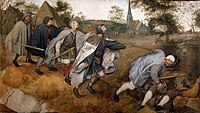
Photo from wikipedia
INTRODUCTION Previous studies have shown increased sensitivity to auditory motion in early blind (EB) individuals. However, the mechanisms underlying this enhanced performance remains unknown. We estimated auditory motion filters in… Click to show full abstract
INTRODUCTION Previous studies have shown increased sensitivity to auditory motion in early blind (EB) individuals. However, the mechanisms underlying this enhanced performance remains unknown. We estimated auditory motion filters in EB using a psychophysical reverse correlation paradigm-the auditory analogue of Neri (2014). METHODS Participants (8 EB and 8 sighted controls (SC)) discriminated the direction of a signal motion (left/right) embedded in broadband noise bursts (500-14,000 Hz) presented over a 10x10 grid (space: -/+30 °; time: 0-800 ms). Amplitude of signal motion was adjusted using staircases to maintain performance at 65%. We made two independent measurements: tuning of auditory motion filters (how noise bursts influence the probability of hearing motion direction), and amplitude threshold for hearing the signal. RESULTS The estimated filters for both EB and SC were predominantly responsive to sound onsets/offsets, different from the non-separable spatiotemporal selectivity previously observed for visual motion. Also, the filters for EB were more accurate in detecting signal onsets/offsets across both space and time. This more refined tuning successfully predicted the greater sensitivity to hear signal motion in EB, as measured by the amplitude threshold (t(14) = -5.59, p < .001). Thus, EB individuals show subtle qualitative rather than quantitative differences in auditory motion processing that nonetheless result in significant improvements in perception.
Journal Title: Journal of vision
Year Published: 2022
Link to full text (if available)
Share on Social Media: Sign Up to like & get
recommendations!